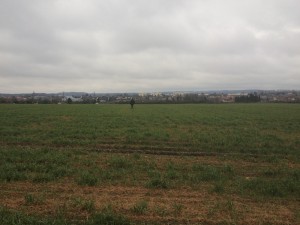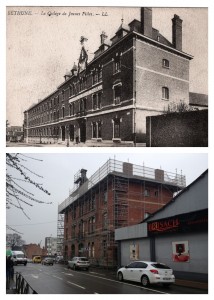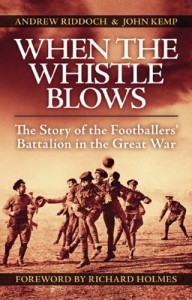Posts Tagged ‘Festubert’
Filming with David Walliams for Who Do You Think You Are? and a look into his great-grandfather’s wartime service
Back in early March just before lockdown I spent a half day filming with David Walliams at the Guards’ Chapel for the new series of Who Do You Think You Are? David’s episode was broadcast tonight, 19 October, on BBC One. I was asked to set the scene for David’s great grandfather, John Boorman, who served in the Grenadier Guards.

With David Walliams at the Guard’s Chapel filming Who Do You Think You Are?
His was a fascinating but ultimately tragic story. Having enlisted at the end of September 1914 it is possible that his above average build (he weighed 140 pounds and had an expanded chest of 36 inches) alongside his height of 5 feet 9 inches meant he was guided in the direction of the Guards by recruiters.
Having undergone training John proceeded overseas. His Medal Index Card and surviving service record confirm his date of arrival in France as 16 March 1915. John joined the 1st Battalion and while the service record does not say when he joined them, the battalion’s war diary notes the arrival of a draft of six officers and 350 men on 20 March 1915. It is assumed John was in this draft.
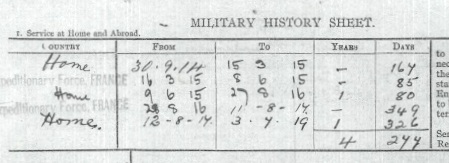
Extract from John Boorman’s service record showing time spent in the UK and overseas
Two months of trench routine and a few weeks break in divisional reserve during which the battalion practice drill and route marching precede John’s first battle, the Battle of Festubert. In comparison to the titanic battles of 1916 & 1917 this affair, in the flat lands of French Flanders, was small but no less bloody. To soften up German positions over 100,000 shells had been fired before the assault. Early in the morning of 16 May the 1st Grenadier Guards followed behind the 2nd Border Regiment, passing through them to attack German trenches. There was no great distance gained and it certainly didn’t alter the course of the war but this action was John’s first taste of the harsh brutality of war. Battalion reports describe close quarter fighting, killing the enemy, taking prisoners plus clearing trenches by throwing bombs. It was a tough baptism of fire, as recorded in Ponsonby’s Volume 1 of The Grenadier Guards in the Great War of 1914-1918:
The 1st Battalion Grenadiers came in for a great deal of shelling, and one shell burst in the middle of No. 8 Platoon, killing four men and wounding many others, including Lieutenant Dickinson and Lieutenant St. Aubyn, who was struck in the face by a piece of shrapnel. All the time a stream of wounded from the front trenches was passing by, some walking and some on stretchers.
Another entry in the Guards’ history records:
Rain began to fall at 6 p.m., and grew into a steady downpour. In the newly won trenches the men were soaked to the skin, and spent a miserable night. Everywhere the wounded, both British and Germans, lay about groaning.
For someone with only two months service in France those images must have made an impression. During the action at Festubert the 1st Battalion lost 2 officers killed, 2 officers wounded and 113 Other Ranks killed, wounded and missing.

Guards at the Battle of Festubert, May 1915
John was invalided back home for fifteen months, suffering from shell shock and returned to France on 28 August 1916. What is unclear is exactly when he rejoined the battalion as September 1916 sees many drafts arrive – 90 Other Ranks on 15th, 60 on 17th, 35 on 19th, 20 on 22nd, 23 on 27th and 72 on the 30th.
Those fresh men were much needed as the battalion was heavily involved in the Battle of the Somme that month. The attack towards the village of Lesboeufs was a costly affair for the Grenadier Guards, now part of the Guards Division. They had been in action on the 15/16th September but it was on the 25th that they took a major part. A few days prior to this the battalion was employed digging assembly trenches from which they would attack. The assault of the 25th was a success with the 1st Battalion passing through other Guards units to take their objective. The war diary has the wonderful line ‘Huns thoroughly demoralised’. Demoralised they may have been, but John’s battalion had paid the price for their success. In 11 days of action from 15-26 September they sustained a staggering 611 casualties.
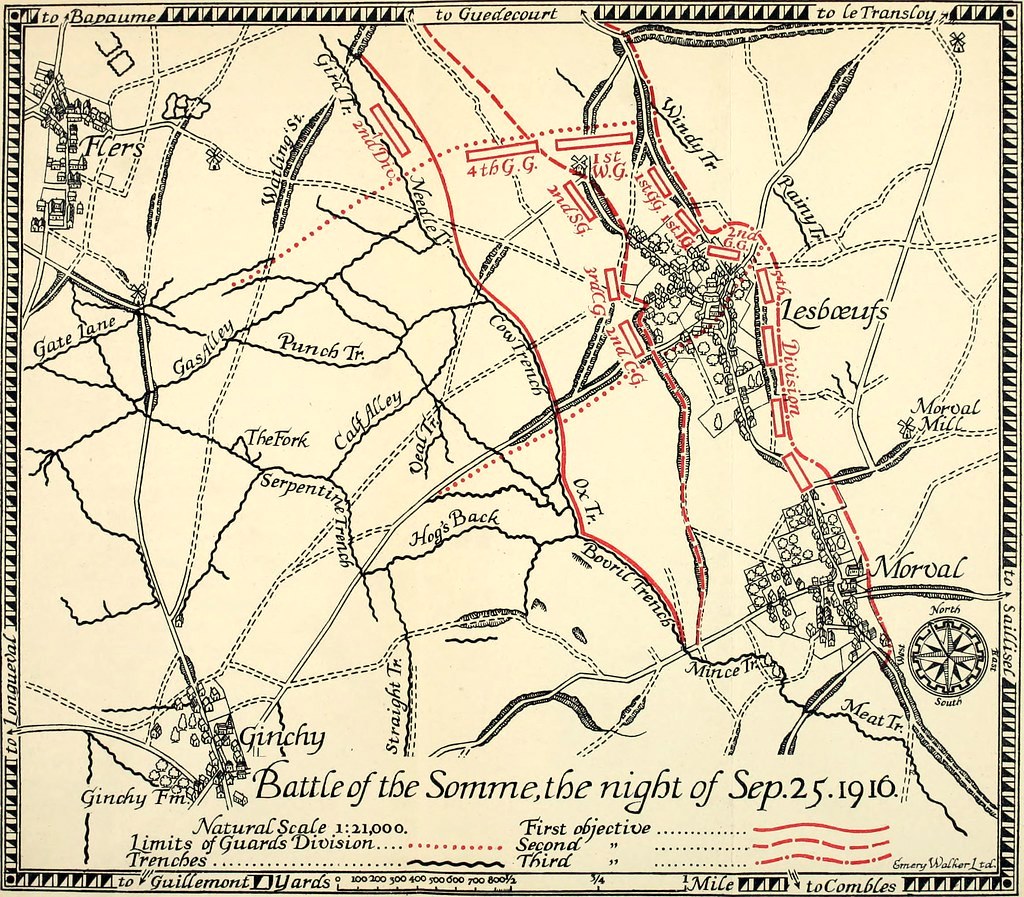
Guards Division on 25 Sept 1916 at the Battle of the Somme
The month of October was spent way out of the line, absorbing new reinforcements and training before moving back to ground west of Lesboeufs in mid-November. By this time the Battle of the Somme was coming to an end. At least the men would no longer have to leave their trenches to assault enemy positions. But that did not mean an end to casualties – enemy shellfire saw to that. Holding exposed shellhole positions joined up to make short sections of trenches, John’s battalion endured mud and tough conditions that the battle had created. Even getting to frontline positions meant miles of trudging along muddy paths and duckboard tracks. Safety, warmth and aid would have seemed a long way away.
Having contended with autumnal mud it was a horribly cold winter with temperatures falling to minus 20 Celsius for a six week period. One blessing of this plummet in temperatures was the mud froze, but so did water…and men. The main enemy at this point was the weather, not the Germans. In mid-March John was admitted to No.34 CCS for treatment of lumbago and “ICT feet”. Having endured such terrible trench conditions many men suffered problems with their feet. It is likely that John moved to a hospital in Rouen, thereby missing his battalion’s part in pursuing the Germans in their retreat to the Hindenburg Line. At some point he rejoined his battalion and moved northward to the Belgian city of Ypres. This was for the start of the Third Battle of Ypres (Passchendaele) during which the Guards Division attacked on the opening day, 31 July 1917.
And for the filming with David, this was as far as I got! I was asked to set the scene for John’s war up to this point. David went over to Ypres and was shown where his great grandfather was wounded. The records show John Boorman arrived back in the UK on 11 August 1917 having been wounded in the left leg below the knee. Despite escaping the horrors of the battlefield John’s war continued. In April 1918 he was admitted to hospital and found to be suffering from mental instability (delusional insanity). A few months after he was transferred to the County of Middlesex War Hospital which contained a specialist military mental hospital. Sadly, it appears John never recovered from the mental scars of service on the Western Front and died, still in care, in 1962. His is a tragic story that reminds us of the enduring effect that war had on many men. While some seemed to return to civvie life and get on with things, return to work, raise a family and function normally, other men were unable to do so and suffered mental anguish for the rest of their lives.
My thanks to the estimable Chris Baker of https://www.fourteeneighteen.co.uk/ who did so much of the research into John Boorman’s story and provided me with a copy of the report he had prepared for Wall to Wall.
JB
The internet is a wonderful thing; for anyone interested in a certain battalion or unit it is now possible to hammer a few key words into a search engine and find all sorts of information about their part in major, set-piece battles. Forums and discussion groups also have their place. Some regimental museums have even transcribed all of their battalion war diaries, making them available online for free.
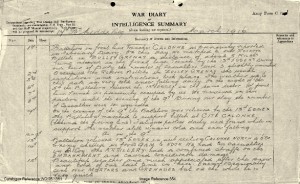
Extract from the 17th Middlesex Regiment War Diary. Reproduced with permission of National Archives, Ref: WO95/1361
Libraries, regimental archives and the National Archives all have information available to help understand events. However, what of the vast majority of time spent not going ‘over the top’ or taking part in the next ‘Big Push’? What of the less-well chronicled, monotonous but necessary routine of trench warfare?
It can be an immensely satisfying task to follow a unit’s movements around the battlefield; this is often undertaken as part of a family pilgrimage or greater desire to ‘follow in the footsteps’ of a relative who served. For me, when battlefield guiding, it is the part of the job that I love the most. Don’t get me wrong – I enjoy a general tour around the main tourist sites as well as the next person but it is in analysing the minutiae of war diary entries and working out such mundane things as billeting arrangements or where sports events were held that yields most fulfilment.
I recently returned from a bespoke trip following the 17th Middlesex Regiment (Footballers’ Battalion) around various villages and towns in French Flanders and the Gohelle coalfields in which they spent November 1915 – March 1916. My client’s grandfather had enlisted underage and spent four months with the battalion before being wounded in mid-March 1916; a wound which saved him from taking part in the Battalion’s action at Deville Wood on the Somme. During the four month period the Battalion held trenches at Cambrin, Givenchy-lès-la-Bassée and Festubert before taking over the Calonne sector from the French at the end of February.
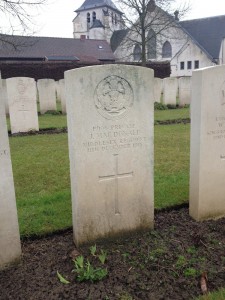
Private James MacDonald, 17th Middlesex – first casualty of the battalion at Cambrin Churchyard Extension
Over the course of our three day trip we visited all of these places, as well as many not associated with the 17th Middlesex; Fromelles, Aubers, Hulluch and Loos. Our stops were not solely restricted to places but included visits to 17th Middlesex Regiment men who had been killed in action. To stand at the grave of Donald Stewart (who served under the alias of Private James MacDonald) in Cambrin Churchyard Extension and know he was the first man of the battalion to be killed in action struck a particular chord. However, for me the highlight came during our visit to Béthune. The Battalion war diary for 2 December records a move to Béthune and billeting in the College des Jeune Filles. I had an old postcard of the college and knew the greater part of it still stood so arranged to visit it during our lunch stop.
Battlefield guides will recognise the satisfying feeling – being able to tell someone that their relative was at that spot on a certain date, not nearby or somewhere in the town but here, actually here. We had the same feeling eating our lunch of ham and cheese baguettes in the square at nearby want to buy ambien online Beuvry. A poorly-attended market filled half of the square but, as we sat eating, I was able to explain that this village, now almost a suburb of Bethune was where the Footballers’ Battalion had spent Christmas Day 1915. There was no plaque commemorating this event, no visible link at all, just the knowledge that men of the Battalion would have walked around the square over the festive time, amongst them my client’s grandfather. It made the lunch, eaten in the car whilst a steady drizzle fell that bit more special.
After a tour around the Loos battlefield I took my client to the site of Middlesex and Football Trench in the Calonne North sub-sector. It was here in that his grandfather was wounded in March 1916. The war diary of the 16th records ‘4 casualties occurred from GRENADES, 2 in “B” Coy and 2 in “D” Coy’; it is likely that my client’s grandfather was one of those wounded men as he left France on the 18th, crossing the channel for treatment at a hospital in Britain. Such were the effect of the wounds received that he was discharged from service three months later. Compared to many who served, his war was unremarkable – his service record shows he played no part in any major offensive and yet the four months he spent with the 17th Middlesex from November 1915 – March 1916 had a profound effect on him for the rest of his life.
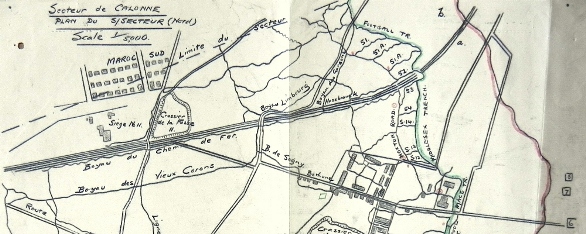
Map of Calonne North Sector showing Football and Middlesex Trenches . Reproduced from 6th Infantry Brigade War Diary held at National Archives, Ref: WO95/1353
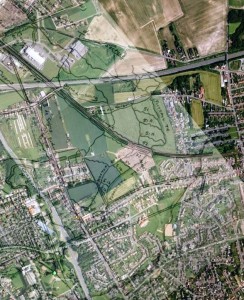
Calonne North map overlaid on to Google Earth. Football Trench runs between the A21 motorway and the Lens – Bethune railway embankment.
Football Trench ran through what is now an open field next to the A21 motorway and the urban sprawl of miners’ cottages of Liévin. The railway line from Lens to Bethune runs across the northern tip of Middlesex Trench. Much of the rest of it is hidden under a civilian cemetery or is being built upon for new housing. A casual visitor to the site today would find it far from enchanting. Locals stared at our car with British number plates; clearly, the back streets of Liévin didn’t see too many battlefield tourists. However, the relative inaccessibility of the spot made visiting it that bit more special. To those of us in the car, it felt as though we had tracked down a site rather than merely followed the tourist signs. Having researched the young Middlesex soldier it certainly had an effect on me. It was a real pleasure to be able to share these places with his grandson; not just the obvious sites of front line and communication trenches but the places in he was billeted, the towns and villages he would have known well and the roads he marched along on his route to and from the front. To me, this is what makes following in a soldiers footsteps such an enriching experience.
N.B. A very readable account of the 17th Middlesex Regiment is Andrew Riddoch & John Kemp’s ‘When the Whistle Blows: The Story of the Footballers’ Battalion in the Great War’ – highly recommended.

